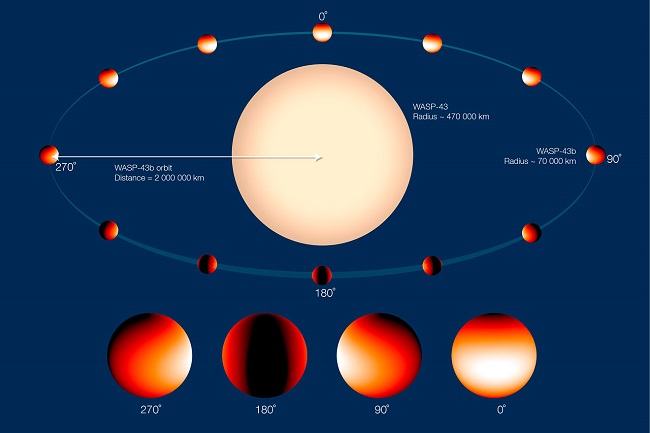An image taken from the Space Shuttle Atlantis just after the Hubble Space Telescope was intercepted by the shuttle's robotic arm during Servicing Mission 4. Image via NASA
The Hubble Space Telescope has captured the most detailed weather map to date of an exoplanet, WASP-43b as it’s officially known, and how much water it could contain.
A similar size to Jupiter, the exoplanet is twice the mass of our solar system’s biggest planet but is unique in that it has the shortest year for any planet of that size known to us, at just 19 hours.
Through using Hubble, a team of researchers from both US space agency NASA and the European Space Agency (ESA) have created two companion pieces, the first of which measured the planet’s atmospheric temperature through its various layers, while the second study was able to find the amount of water vapour contained within the planet.
Form their observations, the planet, which always has one hemisphere facing toward its neighbouring star, is a violent place, where winds as fast as the speed of sound circle the planet, while the hemisphere facing the star has an average temperature of around 1,500°C, enough to melt most metals.
Meanwhile, the other side of the planet pitched in darkness it is a ‘little cooler’ at 500°C.

The colour scale on the planet represents the temperature across its atmosphere based on data from mapping the temperature of WASP-43b in more detail than has been done for any other exoplanet. Image via NASA, ESA, and Z. Levay (STScI)
Measuring water on WASP-43b
The research team led by Kevin Stevenson from the University of Chicago was particularly interested in being able to measure the planet’s water.
Derek Homeier of the École Normale Supérieure de Lyon and one of the co-authors on the project, elaborated further on WASP-43b’s water vapour levels.
“Space probes have not been able to penetrate deep enough into Jupiter’s atmosphere to obtain a clear measurement of its water abundance. But this giant planet is different.
“WASP-43b’s water is in the form of a vapour that can be much more easily traced. So we could not only find it, we were able to directly measure how much there is and test for variations along the planet’s longitude.”
In this exoplanet’s case, their results showed it had the same amount of water as would be expected with an object of the same chemical composition as our own sun.
Don’t miss our Innovation Ireland Forum on 24 October in the Guinness Storehouse, Dublin